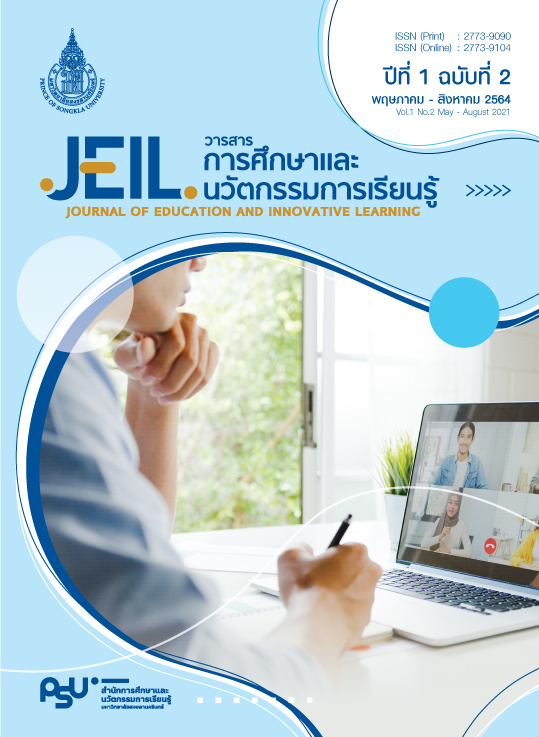ประสิทธิผลของรูปแบบการจัดการเรียนการสอนเชิงบูรณาการกับการทำงาน (WIL) กรณีศึกษารายวิชาการจัดทำโครงการและการวิเคราะห์โครงการ
Main Article Content
บทคัดย่อ
สำหรับการเรียนการสอนในปัจจุบัน จะเน้นเพียงการบรรยายภายในชั้นเรียนเพียงอย่างเดียวไม่ได้ จำเป็นอย่างยิ่งที่จะต้องให้ผู้เรียนได้มีโอกาสออกไปเรียนรู้ภายนอกห้องเรียน และยิ่งเป็นผู้เรียนที่เรียนทางด้านรัฐประศาสนศาสตร์ที่มีผลลัพธ์การเรียนรู้ที่คาดหวัง ข้อหนึ่งที่สำคัญในการผลิตบัณฑิตที่มีภาวะผู้นำด้วยแล้ว ผู้สอนยิ่งต้องมีการจัดสภาพแวดล้อมในการส่งเสริมการเรียนรู้ที่เหมาะสมมากขึ้น วัตถุประสงค์การวิจัยเพื่อศึกษาประสิทธิผลของการนำรูปแบบการจัดการเรียนการสอนเชิงบูรณาการกับการทำงาน มาประยุกต์ใช้ในการเรียนการสอนในรายวิชา การจัดทำโครงการและการวิเคราะห์โครงการให้กับนักศึกษาหลักสูตรรัฐประศาสนศาสตรบัณฑิต สาขาวิชาการจัดการรัฐกิจ ชั้นปีที่ 3 ทั้งนี้ ผู้สอนมอบหมายให้ผู้เรียนได้เรียนรู้โดยใช้โครงงานเป็นฐาน มีการคิดโจทย์ความต้องการร่วมกันกับชุมชน ซึ่งมีวัตถุประสงค์สำคัญเพื่อให้นักศึกษาสามารถบูรณาการการบริการวิชาการเข้ากับการเรียนการสอนได้อย่างมีประสิทธิภาพ และสามารถตอบสนองโครงการได้ตรงตามความต้องการของชุมชน/สังคม ผู้สอนได้มีการออกแบบการจัดการเรียนการสอนร่วมกันกับผู้เรียนตลอดระยะเวลา 15 สัปดาห์ โดยสามารถแบ่งออกเป็น 3 ขั้นตอน ได้แก่ 1) การเตรียมโครงการ 2) การอนุมัติโครงการ 3) การบริหารโครงการ การศึกษานี้เป็นการวิจัยเชิงคุณภาพ ซึ่งมีการเก็บข้อมูลโดยวิธีการสังเกตแบบมีส่วนร่วม การสัมภาษณ์แบบกึ่งมีโครงสร้างและการประชุมกลุ่ม หลังจากการจัดโครงการเพื่อรับฟังผลสะท้อนกลับ โดยมีการจดบันทึกข้อมูล วิเคราะห์เนื้อหา และสรุปประเด็น
ผลการวิจัยพบว่า จากการใช้วิธีการจัดการเรียนการสอนดังกล่าวให้แก่ผู้เรียน ผลสัมฤทธิ์ทางการเรียนของผู้เรียนเมื่อจำแนกการเรียนรู้ตามแนวทางของ Bloom’s Taxonomy นั้น ด้านพุทธิพิสัยผู้เรียนสามารถบูรณาการและสังเคราะห์โครงการต่าง ๆ ให้แก่ชุมชนได้ตามวัตถุประสงค์ โดยมีจำนวนโครงงานซึ่งเป็นผลจากการจัดการเรียนการสอนทั้งหมด 6 โครงการ ในด้านทักษะพิสัยผู้เรียนสามารถคิดค้น สร้างโครงการรูปแบบใหม่ให้ตรงกับความต้องการของแต่ละชุมชนได้อย่างสร้างสรรค์ ในด้านจิตพิสัยผู้เรียนมีการตอบสนองต่อโครงการที่จัดทำด้วยความเต็มใจและมีความซาบซึ้งจากการได้เข้าไปช่วยเหลือชุมชน ในด้านทักษะทางสังคม พบว่า ผู้เรียนมีการพัฒนาการสื่อสาร การทำงานเป็นกลุ่ม การจัดการ และความสามารถในการเป็นผู้นำซึ่งสอดคล้องกับผลการเรียนในระดับรายวิชาและของหลักสูตร
Article Details

อนุญาตภายใต้เงื่อนไข Creative Commons Attribution-NonCommercial-NoDerivatives 4.0 International License.
เนื้อหาและข้อมูลในบทความที่ตีพิมพ์ในวารสารการศึกษาและนวัตกรรมการเรียนรู้ ถือเป็นข้อคิดเห็นและความรับผิดชอบของผู้เขียน ซึ่งกองบรรณาธิการวารสาร ไม่จำเป็นต้องเห็นด้วยหรือร่วมรับผิดชอบใด ๆ และไม่สงวนสิทธิ์การคัดลอกบทความเพื่อใช้ประโยชน์ทางวิชาการ แต่ให้อ้างอิงข้อมูลแสดงที่มาของบทความทุกครั้งที่นำไปใช้ประโยชน์
เอกสารอ้างอิง
Adecco. (2020, November 5). 10 Skills for 2025. Retrieved from https://adecco.co.th/th/knowledge-center/detail/10-skills-for-2025 [in Thai]
Anderson, L. W., Krathwohl, D. R., Airasian, P. W., Cruikshank, K. A., Mayer, R. E., & Pintrich, P., … Wittrock, M. C. (2001). A taxonomy for learning, teaching and assessing: a revision of Bloom’s taxonomy of educational objectives. New York: Pearson, Allyn & Bacon.
Bloom, B. S. (Ed.), Engelhart, M. D., Furst, E. J., Hill, W. H., & Krathwohl, D. R. (1956). Taxonomy of educational objectives, handbook I: the cognitive domain. New York: David McKay.
Chaiyasain, C. (2019). Reflections from students on work integrated learning model with outcome-based education to linkage and support with life long learning skills: case study on “food and beverage operations and management course”. Joint international education conference: The 8th PSU education conference & 4th inspirational scholar symposium (ISS) 2019. Prince of Songkla University, Thailand. [in Thai]
Chandio, M. T., Pandhiani, S. M., & Iqbal, S. (2016). Bloom’s taxonomy: improving assessment and teaching-learning process. Journal of education and educational development, 3(2), 203-221. doi:10.22555/joeed.v3i2.1034
Churches, A. (2009). Bloom’s digital taxonomy. Retrieved from http://edorigami.wikispaces.com/Bloom%27s+Digital+Taxonomy
Duzenli, T., Yilmaz, S., & Alpake, E. M. (2017). The effects of model making on design and learning in landscape architecture education. Eurasian journal of educational research, 70, 121-134. doi:10.14689/ejer.2017.70.7
Elmore, R. F. (2019). The future of learning and the future of assessment. ECNU review of education. 2(3), 328-341. doi:10.1177/2096531119878962
Kattiyaman, W., & Piyapimonsit, C. (n.d.) Improving Bloom’s educational aims. Retrieved from http://www.watpon.com.th [in Thai]
Krathwohl, D. R. (2002). A revision of Bloom’s taxonomy: an overview. Theory into practice, 41(4), 212-218. doi:10.1207/s15430421tip4104_2
McLennan, B., & Keating, S. (2008, June). Work-integrated learning (WIL) in Australian universities: The challenges of mainstreaming WIL. Paper presented at the ALTC NAGCAS national symposium, Melbourne, Australia.
Office of the National Economic and Social Development Council. (2020). 12th National economic and social development plan. Retrieved from http://www.nesdb.go.th [in Thai]
Orrell, J. (2011). Good practice report: work-integrated learning. Retrieved from https://ltr.edu.au/resources/GPR_Work_Integrated_Learning_Orrell_2011.pdf
Pinkesorn, K., Kittisaknawin, C., & Kongkla, C. (2017). Human capital: corporate human capital scorecard. Journal of Graduate Studies Valaya Alongkron Rajabhat University, 11(2), 193-202. [in Thai]
Pradubwate, R. (2017). Technology learning management guidelines by using Bloom’s taxonomy. Veridian E-Journal, Silpakorn University, 10(3), 1051-1065. [in Thai]
Sankaburanurax, A. (2016). Development of art-based teaching styles to promote creative work for undergraduate students (Doctoral dissertation). Silpakorn University. [in Thai]
Son, H. H. (2010). Human capital development. ADB economics working paper series No. 225. Manila: Asian Development Bank. doi:10.2139/ssrn.1695806
Wongthongdee, S. (2014). Human resource development (2nd ed.). Bangkok: Chulalongkorn Press. [in Thai]
Yawai, A., Vongchavalitkul, N., Sattayanuchit, W., Tanaworakul, N., & Pattamawipak, A. (2019). Development of learners learning outcomes by the creating of learning condition in the real condition. (Research Report No. RDG6140038) Retrieved from Research on The Thailand Research Fund website: https://www.ubu.ac.th/web/files_up/00046f2019071017175859.pdf [in Thai]
Yoelao, D. (2014). PBL learning management from the construction project knowledge set to enhance the skills of the 21st century of children and youth: from the success experience of thai schools. Bangkok: Thiphayawisut Ltd., Part. [in Thai]


